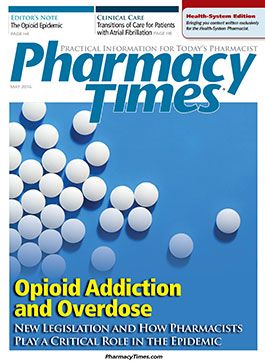Publication
Article
Pharmacy Practice in Focus: Health Systems
The Opioid Epidemic: Can Health-System Pharmacists Help?
I wonder if health-system pharmacists who read and hear about the growing opioid epidemic react as if this is someone else's issue.
I wonder if health-system pharmacists who read and hear about the growing opioid epidemic react as if this is someone else’s issue. Because many of us work in the acute care setting and this is primarily an ambulatory issue, it is easy to be a passive observer. I think there are many opportunities for health-system pharmacists to be actively involved in reducing opioid overuse.
A few important points stress the need for vigilance:
- Eighty percent of all opioid use in the world occurs in the United States. This is an incredible statistic when you consider that Americans make up only 5% of the world’s population.1
- During the time leading up to his nomination as FDA Commissioner, Rob Califf, along with the FDA, has called for policies and processes to assist in reversing the epidemic.2 This has become a major issue for the FDA.
- In March, President Obama announced additional actions to help reduce opioid abuse.3 The White House is actively becoming involved in addressing it.
When recognizing the sheer size of the problem and the importance that governmental officials have placed on this epidemic, healthsystem pharmacists need to actively join the fight to limit inappropriate opioid use. Because we spend so much time ensuring appropriate medication use, this seems appropriate, and we are well trained to do it. Here are some things we can do:
- Ensure that the approach to ordering controlled substances at your institution is sound. The number of individuals who have ordering privileges and power of attorney should be minimal, and there need to be appropriate checks and balances. If 1 individual manages the entire ordering and inventory process, the opportunity for diversion increases.
- Have a process for checking waste in procedural areas. A large opportunity for diversion occurs during procedures because syringes are pre-drawn and then wasted if not used. Every provider needs to be aware that the pharmacy will regularly check waste that is returned for disposal for diversion reasons.
- Establish a routine monitoring program. Frequently generating reports to identify outliers among individuals who administer controlled substances is essential. Unfortunately, departments do not routinely do this. Although it is not exciting to consistently generate these reports, and never enjoyable to identify a diverter, having the discipline to do this regularly and robustly is essential to all pharmacy departments.
- Use the state’s controlled substances reporting system (CSRS) for patients at risk for misuse during each medication history. Pharmacy departments are getting active in taking a medication history upon admission, and few even review the CSRS as part of this process. Although this is an important step in the medication reconciliation process, it is also an opportunity to identify an abuser who is getting frequent prescriptions. Actively reviewing the CSRS for these suspected patients can provide information to the medical team in order to address issues during admission.
- Ensure the formulary has limited controlled substance availability and appropriate restrictions on prescribing. Although pain management is very important in the acute care setting, a designated individual needs to ensure that needless or inappropriate medications are not stocked and that only individuals who should prescribe some of these medications are the ones doing so.
- Minimize pain medications at discharge. Educating physicians and monitoring prescriptions to minimize the total amount of doses allowed and the number of refills can help to limit the potential for addiction to start. Although we want to be certain that pain is controlled and patients are comfortable, we also want to make sure patient access is limited beyond this.
- Employ a pain management pharmacist in the ambulatory care setting. Patients can be referred to a pain management pharmacist at discharge if pain does not resolve or is not managed appropriately. Pain management pharmacists can also advise their department on appropriate formulary medications and processes for limiting abuse.
We all have a role in making sure we do not contribute to the growing opioid epidemic. Health-system pharmacists are integral to the process. We need to join our ambulatory care colleagues to make sure all medicines are used appropriately.
I would appreciate any insights and experiences you might have regarding this perspective. Let me know what you think by e-mail at [email protected] or follow me on Twitter at @stepheneckel.
Stephen F. Eckel, PharmD, MHA, BCPS, FCCP, FASHP, FAPhA, is associate director of pharmacy, University of North Carolina Hospitals, and clinical associate professor at the University of North Carolina Eshelman School of Pharmacy.
References
- US: 5% of world population; 80% of opioid consumption. Allgov.com website. allgov.com/news/controversies/us-5-percent-of-world-population-80-percent-of-opioid-consumption-141215?news=855100. Published December 15, 2014. Accessed April 11, 2016.
- Califf, FDA top officials call for sweeping review of agency opioids policies [news release; February 4, 2016]. FDA website. www.fda.gov/NewsEvents/Newsroom/PressAnnouncements/ucm484765.htm. Accessed April 11, 2016.
- Fact Sheet: Obama administration announces additional actions to address the prescription opioid abuse and heroin epidemic [new release; March 29, 2016]. whitehouse.gov website. whitehouse.gov/the-press-office/2016/03/29/fact-sheet-obama-administration-announces-additional-actions-address. Accessed April 11, 2016.

Newsletter
Stay informed on drug updates, treatment guidelines, and pharmacy practice trends—subscribe to Pharmacy Times for weekly clinical insights.






